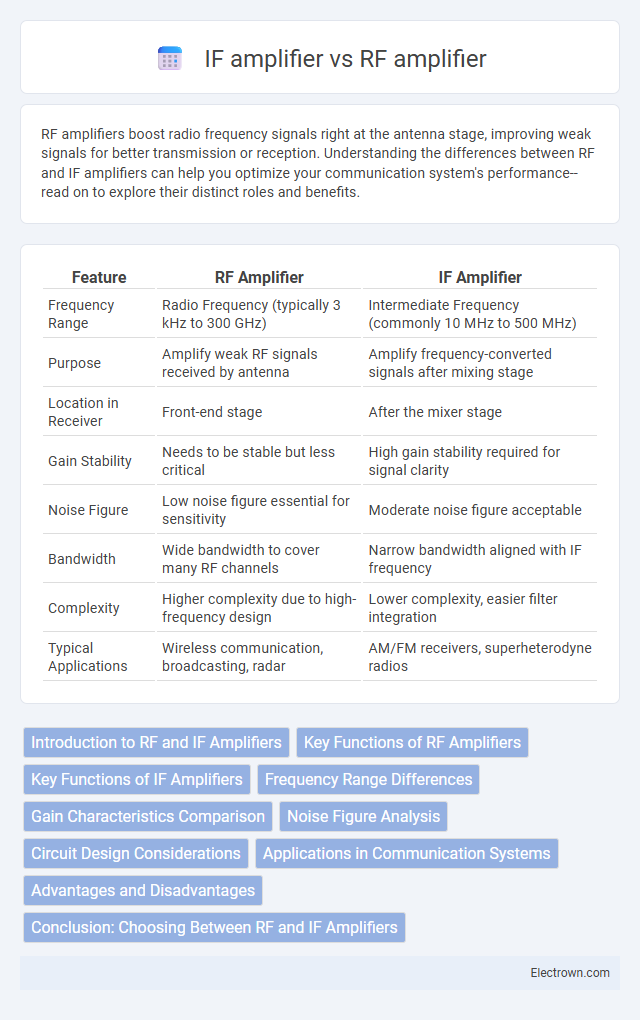RF amplifiers boost radio frequency signals right at the antenna stage, improving weak signals for better transmission or reception. Understanding the differences between RF and IF amplifiers can help you optimize your communication system's performance--read on to explore their distinct roles and benefits.
Table of Comparison
| Feature | RF Amplifier | IF Amplifier |
|---|---|---|
| Frequency Range | Radio Frequency (typically 3 kHz to 300 GHz) | Intermediate Frequency (commonly 10 MHz to 500 MHz) |
| Purpose | Amplify weak RF signals received by antenna | Amplify frequency-converted signals after mixing stage |
| Location in Receiver | Front-end stage | After the mixer stage |
| Gain Stability | Needs to be stable but less critical | High gain stability required for signal clarity |
| Noise Figure | Low noise figure essential for sensitivity | Moderate noise figure acceptable |
| Bandwidth | Wide bandwidth to cover many RF channels | Narrow bandwidth aligned with IF frequency |
| Complexity | Higher complexity due to high-frequency design | Lower complexity, easier filter integration |
| Typical Applications | Wireless communication, broadcasting, radar | AM/FM receivers, superheterodyne radios |
Introduction to RF and IF Amplifiers
RF amplifiers operate within the radio frequency spectrum, typically ranging from 3 kHz to 300 GHz, amplifying weak signals received by antennas for improved transmission and reception quality. IF amplifiers work at intermediate frequencies, often between 45 MHz and 455 kHz, providing selective amplification and enhanced signal processing after frequency conversion in superheterodyne receivers. Both amplifiers crucially support wireless communication systems by optimizing signal strength and clarity at different stages of the signal processing chain.
Key Functions of RF Amplifiers
RF amplifiers primarily boost weak radio frequency signals received by antennas to improve signal strength before processing. They enhance signal-to-noise ratio and sensitivity in communication systems, enabling clearer transmission and reception over long distances. RF amplifiers operate within specific frequency bands, preserving the signal's integrity while minimizing distortion and interference.
Key Functions of IF Amplifiers
IF amplifiers primarily amplify intermediate frequency signals to improve signal strength and selectivity within receivers, enhancing overall sensitivity. They provide consistent gain and stability, ensuring effective filtering and noise reduction before demodulation. Key functions include signal amplification at a fixed frequency and facilitating better image rejection and signal processing compared to RF amplifiers.
Frequency Range Differences
RF amplifiers operate primarily within the radio frequency spectrum, typically ranging from 3 kHz to 300 GHz, optimizing signal strength at the front end of communication systems. IF amplifiers function at intermediate frequencies, commonly between 30 kHz and 500 MHz, where signals are converted for easier processing and filtering. Understanding the distinct frequency ranges of your RF and IF amplifiers ensures optimal system design and signal integrity.
Gain Characteristics Comparison
RF amplifiers typically exhibit higher gain variability due to frequency-dependent signal attenuation and noise factors at radio frequencies, with gains often ranging from 10 to 30 dB. IF amplifiers provide more stable and linear gain characteristics, commonly achieving gains between 20 and 40 dB, owing to the fixed intermediate frequency and improved filtering capabilities. The gain stability of IF amplifiers makes them ideal for sensitive receiver designs where consistent signal amplification is critical.
Noise Figure Analysis
RF amplifiers typically exhibit higher noise figures than IF amplifiers due to their operation at higher frequencies where noise contributions from device parasitics and external interference are more significant. IF amplifiers benefit from lower frequency operation and more controlled impedance matching, resulting in improved noise figure performance and enhanced signal-to-noise ratio in communication systems. Accurate noise figure analysis is crucial for optimizing the overall receiver sensitivity and ensuring efficient amplification across RF and IF stages.
Circuit Design Considerations
RF amplifier circuit design requires meticulous impedance matching and high-frequency stability to minimize signal loss and distortion at the radio frequency stage. IF amplifier design emphasizes selective filtering, gain stability, and noise figure optimization to enhance signal clarity in the intermediate frequency range. Your choice between RF and IF amplifiers depends on balancing these factors to achieve the desired performance in communication systems.
Applications in Communication Systems
RF amplifiers are critical in communication systems for boosting weak radio frequency signals received by antennas, enabling effective transmission and reception in wireless devices such as cellular phones and radios. IF amplifiers operate at intermediate frequencies, enhancing selectivity and signal quality in superheterodyne receivers by amplifying signals after frequency conversion. Your communication system's overall performance depends on the precise use of RF amplifiers for front-end sensitivity and IF amplifiers for signal processing and noise reduction.
Advantages and Disadvantages
RF amplifiers deliver superior signal gain and noise figure at radio frequencies, making them ideal for front-end signal processing, but they often consume more power and can introduce distortion due to high-frequency operation. IF amplifiers provide consistent gain and better selectivity at intermediate frequencies, enhancing signal stability and filtering capabilities, though they may add complexity to the design and system cost. Understanding the trade-offs between your RF amplifier's high-frequency performance and your IF amplifier's filtering precision helps optimize overall system efficiency.
Conclusion: Choosing Between RF and IF Amplifiers
Selecting between RF and IF amplifiers depends on the specific application requirements such as frequency range, gain, and noise figure. RF amplifiers operate at radio frequencies and are essential for initial signal amplification with minimal noise, while IF amplifiers work at intermediate frequencies, providing better selectivity and stability. Engineers prioritize RF amplifiers for front-end reception and IF amplifiers for signal processing, ensuring optimized performance in communication systems.
RF amplifier vs IF amplifier Infographic

 electrown.com
electrown.com